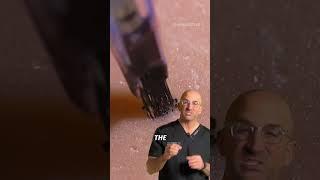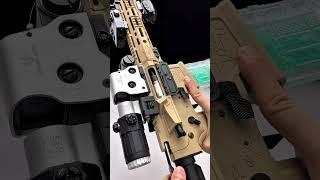
SpaceX Is Adding Another Heat Shield Layer To Starship
Комментарии:

Winning
Ответить
Another heat shield layer... at the cost of payload, sadly. It'll be interesting to see if they manage to lift a payload.
Ответить
Ablative sounds right. It's just a good tradeoff in terms of extra weight of ablative material vs fuel. Temps for that could be much cooler than super high temp tiles constantly being heated.
Ответить
Did the booster and starship sink on landing in the sea or will
they be floating and returned? No one has mentioned that they sank.

If they do manage to land the booster, they are then stuck with an old booster on the pad that they then need to dismantle.
I guess the chance to see up close the exact wear on it would be valuable, but it will require quite a bit of dismantling effort afterwards.

At some point, even though the reusability might not be perfected, Starship will be able to confidently deliver payload to orbit. So it might turn profitable and useable before reusability is achieved, at which point they can take their time to perfect the design while not going at a loss with each launch. Amazing what they’ve already achieved and shown capable of.
Ответить
May be the flaps should be made of matrix ceramic instead of stainless steel in the critical areas.
Ответить
The thing is gonna be a little heavier than it already is? Amazing...
Ответить
Maybe make the flaps and hinges out of tungsten or a tungsten-alloy - no need for heat-tiles!
Ответить
We need to stop kidding ourselves that there will be a rapid reuse or ultra quick turnaround for Starship. It just won't happen with current heat shield tech. The booster? Sure that is most likely achievable. SpaceX will most likely need a fresh Starship ready to be added to the stack while the Starship that just landed goes for refurbishment.
Ответить
Making 2 sets of steering flaps slightly off-aligned at the back. So when re-entry, the ones most located at the back of the ship stay more out of the heath... and it provides an extra safety for when one set fails out i think.
Ответить
Speaking about "safety nets"...
Ответить
Excellent. Starship is getting even heavier and less capable :) Oh btw, did Musk actually say they would fix the tiles, properly?
Ответить
Great channel indeed. Just the news, no bs. Super
Ответить
More weight and even less payload! The only reason they use those crappy ceramic tiles is weight or better mass. After seeing the launch I'd say just fix those damn wings first. The ceramic tiles are even worse for moving parts.
Ответить
Why not make one giant tile in the shape of the fuselage?
Ответить
ROFL, it was roasted to melting point, bits falling off, tiles, most of one wing. Go watch the video again.
How pleased do you think NASA is of this latest effort that passed zero technological milestones they were supposed to have passed over 3 years ago?
Still it pays your bills right?

Thank you for straight up info, well presented
Ответить
There was a thinner tile next to the missing tiles. I thought that could be a lighter tile but that could have been the secondary oblative tile.
Ответить
Use at least 3-4 seconds scenes before switching to the next.
Ответить
Ablative?? Doesn't that defeat the purpose of re-usability?
To the person with diminutive brain capacity who replied: a heat shield is not comparable to fuel. Do you have to re-coat the inner lining of your car's carburetor every time you drive, because half the aluminum alloy ablated off? That's the real comparison.

We're in the "business end" of the developmental phase now folks! Heat Shield development! Because if... When... SpaceX cracks this problem, then they will finally have a viable, human rated vehicle! And the rest of the hurdles from then on, should be reasonably easy to solve once they've solved this! At least as far as Moon missions are concerned!
So yeah... I suspect that this will be the MAIN focus going forward!

I'm starting to think that Musk is serious about reusing the Starships. Let's Go!!!
Ответить
Any solution using tiles and heat shield will not be rapidly reusable. We know this from the Space shuttle.
Better go back to the drawing board and think about something drastically different.

You don't find out where the line is until you cross it. Anyone who calls this flight a failure has no idea how rapid prototyping or engineering in general works. You have to break shit to find out how to make it unbreakable.
Ответить
"Seem to be on the right track, which is a promising sign." Track and Sign. Mixed metaphor. Typical of YT public speakers who should have studied English composition instead of geeking out on space-travel, if they want to narrate. If its computer generated, there is no excuse.
Ответить
Using ablative materials, wont this drastically increase turn around time ?
Ответить
Interesting video with good content, but as a native English speaker, I find the commentary not easy to understand and sometimes I miss a few words as they are pronounced too rapidly and softly.
Ответить
I don't understand why this is so hard. Space Shuttle worked on the first try with 70s technology. Isn't starship substantially less complicated than shuttle? After the benefit of 50ish years of material/rocket/computer science shouldn't reentry be... trivial?
I think musk set all of your expectations in the dumpster and SpaceX fans behave like abused girlfriends. "But you don't understand how hard he's trying and how smart he iiissss! 😭"

Tin cans in spaaaaace!
Ответить
Payload capacity reduction.
Ответить
Elon now is aware that rapid vehicle turnaround is his fantasy .
Ответить
I love alll SpaceX, and Tesla. Elon Musk have a special place in my heart. But i still think that BFR would be great as a Space Plane on Second Stage, some modern version of Space Shuttle that still can land on back/stand up on planets/moons without atmosphere.
Ответить
Make sense & gets rid of the wing flappers.
Ответить
The Space shuttle is a better design.
Ответить
Fish Scales.
Ответить
I wish SpaceX would test a section of the heat shield with a transpirational cooling area to see if their original idea has merit. Those tiles must add a lot of weight. And if they have to add an ablator behind the tiles, that's even more weight. So the question becomes, would the fuel/weight penalty for using transpirational cooling be more than the penalty of a conventional heat shield? And would the holes required to expel the cooling vapor be too prone to clogging to be reliable?
If that method proved effective, I think it would be much better for reusability than heat shield tiles. The tiles on the Space Shuttle were its most maintenance intensive area that slowed down reuse and increased costs massively.
I hate to see SpaceX be forced down that road. They chose stainless steel for its cost, ease of manufacture, and durability. It is time to try to maximize its utility by trying the transpirational cooling method.

I expect a destroyed launch tower if SpaceX tries to catch a booster. It seems like a more logical solution is to suck it up, take the weight hit, and put landing legs on the booster, then let it land on a pad mounted on rails. The landing pad could do double duty for propulsive landings of Starships. I mean the damned thing is eventually going to need landing legs for Mars anyway. Might as well suck it up now and put them on.
The rails would allow them to move the booster back to the launch pad for reuse, while protecting the extremely expensive and valuable launch pad.
Putting so much important equipment on the Stage 0 launch pad might be OK for saving weight, but it is an enormous risk. Destroying a pad is expensive and cuts your launch abilities in half, assuming you have a second pad. Even if they "perfect" catching a booster or Starship or both, SpaceX's devotion to the "no part is the best part" ethos works against the redundancy that is required for reliability. That makes the odds of a malfunction or hardware failure more likely, and the danger of a stage 0 disaster an expectation somewhere down the line.

Very little fuel in the booster tanks will prevent an explosion??????????
Have you forgotten those explosions of the test Starships when they fell over on landing???
That's what you get with "nearly empty propellant tanks".

Is it possible to also add a magnetic field around the starship for more redundancy against ionized gases .
Ответить
If you want any credibility you’ll need better sources than “Elon said”.
Ответить
he speaks the last word of every sentence, too softly. It's too distracting.
Ответить
Why this weird robotic voice? Get someone normal to do the talking.
Ответить
Try a smaller rocket with the various tiles or surfacing and run it through the reentry tests. Why such a huge device to test ablatives ??? No quick turn around for this setup. Bummer but just scale it, cracks and dislodging fixes should not burn through it. Installing electro-gravs will also help reduce the mass/fuel needed, ask Eugene Podkletnov how to do this.
Ответить
Love your videos, any way you could add background music to your videos?
Ответить
Multiple heat shield is best solution, tiles stick together or separate ss plate with tile ( wherever require) recommended
Ответить
Say why does SpaceX continue the space burn after it has separated?? I always heard that once in space ..once in motion it will keep traveling through space ..so why burn all that fuel ? Same thing when traveling to the moon ..they don't have to refuel ...50 years ago the refueling wasn't on the table ..anyone from SpaceX can reply ??
Ответить
Thinking out loud could Endura Coating's Composite Diamond Coatings (CDC) Specifications Series 1100 be slightly improved to add higher temperature diamond coating adhesion resilience, then coat Starship's stainless steel Flaps, and Space Facing no tile unshielded fuselage side on re-entry to wick away heat from under the new two layer heat shield tiles, and into the plasma stream exiting as a proposed wick away from stainless steel surfaces additional cooling concept, thus stabilizing Starship on reentry by means of improved more stable, even out fluid dynamics flow patterned, while decreasing both flap, and fuselage unwanted abrasion do to evening out localized stainless steel surface heating on StarShip’s many plasma transitioning points from tiled surfaces to non tiled surfaces. Any thermal engineers out there wish to comment on a three layered heat shield system comprised of diamond coated stainless steel surfaces, layer one heat shield, layer two heat shield.
Google Search at “ScienceDirect”: Research Paper titled "Effective thermal conductivity of a diamond coated heat spreader"

If they had a "normal" launch ground system they wouldn't rattle the tiles off, would they?
Ответить

























